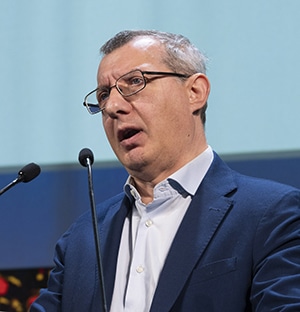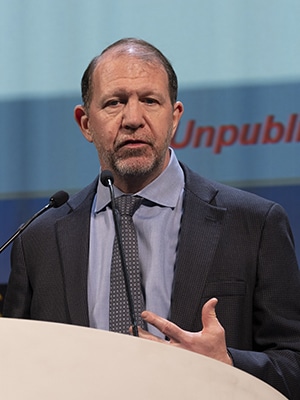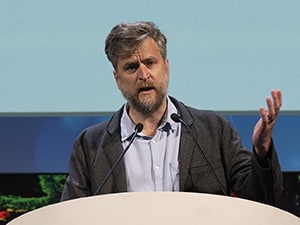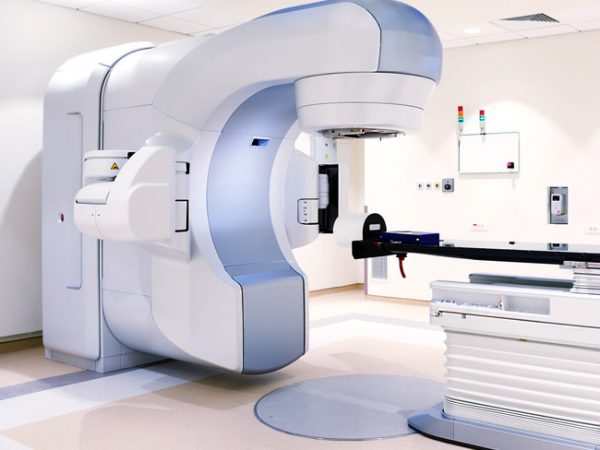AACR Annual Meeting 2023: Demystifying Immune Ecosystems
As the spring weather encourages the planting of flowers, vegetables, and herbs, even careful gardeners may see weeds creeping into their gardens.
Just as a weed corrupts its natural environment to draw nutrients, water, and light from nearby plants, a tumor must also garner support from its surroundings. In particular, it must strike a delicate balance with the immune system, silencing cells that would harm the tumor and boosting the cells that help protect the tumor.
An experienced gardener knows the tricks to disrupt a weed’s environment, causing the invader to wither and die. By studying the intricacies of the tumor immune microenvironment, researchers hope to identify similar vulnerabilities in the tumor’s support system that can be exploited using drugs or other therapies.
“Tumor immune microenvironments are incredibly diverse and will require numerous strategies to control,” said Judith Varner, PhD, a professor of pathology at the University of California San Diego Moores Cancer Center and chair of the fourth plenary session at the AACR Annual Meeting 2023, held April 14-19.
In the session, titled “Embracing Immune Ecosystems,” experts in the field of tumor immunology touched on several potential ways to manipulate the interplay between cancer cells and immune cells.
Luring CAR T Cells
One significant challenge to the use of CAR T-cell therapy in solid tumors involves designing a cell that can locate and physically access all parts of the tumor. In a clinical trial of a CAR T therapy targeting CD30, a prominent antigen on Hodgkin lymphoma cells, tumor size was highly predictive of response, with smaller tumors responding significantly better than larger ones.

“If you have a higher tumor burden, the response is not maintained,” said Gianpietro Dotti, MD, a professor of microbiology and immunology at the University of North Carolina and director of the Lineberger Comprehensive Cancer Center. “These data have been replicated by others, and the persistence of the response remains an issue.”
Dotti and colleagues found that Hodgkin lymphoma cells secrete a cytokine called TARC that recruits helper T cells to the tumor. Given that TARC can attract endogenous T cells, the researchers hypothesized that it could also serve as a beacon for modified T cells.
They engineered their CD30-targeting CAR T cells to also express the receptor CCR4, which recognizes TARC. In mouse models, the CCR4-expressing CAR T cells showed better tumor infiltration and tumor regression than CAR T cells without CCR4.
Dotti and colleagues are testing these cells in a phase I clinical trial of patients with Hodgkin lymphoma and cutaneous T-cell lymphoma. Although the trial is still in the dose escalation phase, and the researchers do not yet have data on their target dose, Dotti suggested that the complete and partial responses observed at lower dose levels suggest better antitumor activity than CD30-targeting cells that lack CCR4.
Sending Antibodies Inside the Cell
Because antibodies circulate in the extracellular space, current antibody-based therapies can only target proteins expressed on the cell surface. Jose Conejo-Garcia, MD, PhD, an associate professor of immunology at the Duke University School of Medicine and a member of the Duke Cancer Institute, is challenging that paradigm with a new discovery.

In a 2021 paper, Conejo-Garcia and colleagues showed that a different type of antibody—dimeric IgA, as opposed to the IgG antibodies typically used for therapeutic purposes—can be internalized into cells upon binding to the polymeric immunoglobulin receptor (pIGR). The IgA-pIGR complexes enter the cell, are trafficked through the intracellular protein sorting system, and are secreted again in a modified state.
The researchers found that pIGR is expressed in most epithelial cancer types, including almost all ovarian, endometrial, and non-small cell lung cancers (NSCLC). They hypothesized that a therapeutic IgA antibody would be able to enter cells of these cancer types and neutralize a mutated cancer driver protein.
Conejo-Garcia and colleagues designed a dimeric IgA antibody targeting KRASG12D and applied it to ovarian cancer cells harboring the mutation. They found that their antibody did more than simply bind to the mutant protein.
“It’s not only that our antibody neutralizes the target inside of the cytoplasm; it carries it away and expels mutant KRAS outside the tumor cell,” Conejo-Garcia said.
In mouse cell xenograft models of KRASG12D ovarian cancer and NSCLC, treatment with the engineered antibody significantly decreased tumor growth compared to treatment with a nonspecific IgA antibody, and it had no effect on the tumor growth of models with wild type KRAS. Further, the IgA antibody decreased tumor growth more robustly than an investigational small-molecule inhibitor of KRASG12D.
“We honestly believe that this can change the way that we treat cancer and pave the way for a new generation of immunotherapies,” Conejo-Garcia said.
Expanding Opportunities for Immune Checkpoint Inhibitors
The first drug combination containing an inhibitor of the immune checkpoint LAG-3 was approved by the U.S. Food and Drug Administration (FDA) in March 2022. The combination, nivolumab and relatlimab-rmbw (Opdualag), also contains an inhibitor of the immune checkpoint PD-1 and was approved to treat patients with unresectable or metastatic melanoma.
While the combination performed well in the RELATIVITY-047 clinical trial, not everyone responded.

“We don’t really understand why it doesn’t work in all patients and which patients might respond or not,” said Dario Vignali, PhD, distinguished professor and interim chair of the Department of Immunology, co-leader of the Cancer Immunology & Immunotherapy Program, and co-director of the Cancer Immunology Training Program at the University of Pittsburgh, associate director for scientific strategy at the University of Pittsburgh Medical Center Hillman Cancer Center, and scientific director of Fondazione Ri.MED in Italy. Vignali stressed that understanding more about the mechanisms of LAG-3 could help address this challenge.
Vignali and colleagues found that LAG-3 directly interacts with the T-cell receptor and its coreceptors, CD8 and CD4. The intracellular portion of LAG-3 sequesters zinc ions, which are necessary to kickstart the T-cell activation cascade, and blocks CD8 and CD4 from interacting with a key downstream regulator.
“LAG-3 acts not as an inhibitory receptor but as a signal disruptor,” Vignali explained.
To assess how LAG3 and PD-1 inhibitors work together, Vignali and colleagues started a phase II clinical trial to identify biomarkers that may predict response to nivolumab, relatlimab, or the combination. By sequencing T-cell RNA from patients treated with each therapy, they determined that relatlimab boosts T-cell activity, and nivolumab decreases T-cell exhaustion.
Tumors treated with the combination experienced an additional boost in T-cell activation and resulting cytotoxicity, but they retain their exhaustion phenotype. “This was not expected from previous studies,” Vignali said.
Targeting Macrophage Dysfunction
Immune suppressive cells, such as tumor-associated macrophages, can pose a significant hurdle to cancer immunotherapy. Determining how these cells affect the tumor microenvironment can provide insights into new therapeutics, according to Miriam Merad, MD, PhD, director of the Precision Immunology Institute and the Human Immune Monitoring Center and a professor of oncological sciences, medicine, hematology and medical oncology, and dermatology at the Icahn School of Medicine at Mount Sinai.

Merad and colleagues study two types of tumor-associated macrophages: tissue-resident macrophages (TRMs), which are present in the tissue before the tumor forms, and monocyte-derived macrophages (mo-macs), which arise from another type of immune cell in the blood and bone marrow.
By studying the transcriptional profile of mo-macs, Merad and colleagues found a master regulator gene, TREM2, without which mo-macs could not upregulate their immune suppressive gene profile. In mouse xenograft models, TREM2 deletion or antibody-mediated blockade significantly decreased lung tumor burden and boosted recruitment of natural killer cells.
Merad and colleagues further identified an immune suppressive program of mo-mac gene expression mediated by the cytokine IL-4. Deletion of the IL-4 receptor from myeloid progenitor cells, such as those destined to become monocytes and mo-macs, abrogated mouse tumor growth significantly. The researchers are now testing an IL-4 receptor-targeting antibody, in combination with a PD-1 inhibitor, in a clinical trial of patients with metastatic NSCLC.
“The moonshot challenge of the years to come is to re-engineer the immune system to enhance beneficial inflammation and on-tumor immunity without inducing tissue damage,” Merad said.
Dissecting Macrophage Heterogeneity
Florent Ginhoux, PhD, a senior principal investigator at Gustave Roussy and former trainee of Merad’s, also discussed characteristics of tumor-associated macrophages that support tumor growth. He focused on the idea that macrophages are not a homogeneous population and therefore cannot be targeted as such.
“We cannot consider tumor-associated macrophages a single entity, or just M1 and M2 macrophages,” Ginhoux said. He explained that two key factors can influence macrophage behavior: the origin of the macrophages and the signals they receive from surrounding tissues.

As Merad discussed, macrophages circulating in adults were either formed during embryonic development, like TRMs, or derived from monocytes; the two populations serve different functions.
By labeling a mo-mac specific protein with a fluorescent tag, Ginhoux and colleagues studied how mo-macs and TRMs differentially interact with pancreatic cancer cell xenografts in mice. They found that the transcriptional profiles of the two macrophage types are completely different; notably, TRMs were associated with transcriptional profiles related to local remodeling, while mo-macs were associated with transcriptional profiles related to systemic changes.
TRMs were also more likely to accumulate around the edges of a tumor, while mo-macs were more likely to infiltrate inside the tumor. This pattern was also observed in human pancreatic cancer samples.
Ginhoux demonstrated that there is more to be learned about macrophage lineages as scientists’ ability to track cell evolution improves. Using a model that allows the site-specific labeling of macrophages at different time points, he and his colleagues discovered three different transcriptional programs of mo-macs in mouse pancreatic tumors. One cluster gives rise to the other two, which localize to different places within the tumor.
“We can now reconstruct the full life of these macrophages by doing this time stamping,” Ginhoux said. “Such complexity needs to be embraced—we should not reject it—because it provides unique opportunities to target deleterious cell populations.”



